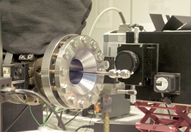UV absorption shock tube

Aim
Shock tubes are frequently used to study the kinetics of high temperature gas-phase reactions. A shock wave that is initiated by a gas expansion heats the reactive gas mixture within less than a microsecond to temperatures up to several thousand Kelvin. The subsequent reaction is observed via optical techniques. The UV absorption shock tube at IVG allows for the time- and wavelength-resolved detection of UV spectra of reacting gas mixtures. One application is the investigation of fluorescence tracers at temperatures relevant to practical combustion engines. These species are hydrocarbons which are added to fuels in order to visualize the fuel/air mixing process in real combustion engines by means of stimulated fluorescence. Furthermore numerous reaction systems can be studied provided that the educts or products posses UV absorption bands.
Approach
The shock tube has a total length of 10.9 m an inner diameter of 80 mm. It is divided by an aluminum diaphragm (up to 300 µm thickness) into a driver section of 3.6 m and a driven section of 7.3 m in length. The reactive gas mixtures are prepared in a stainless-steel mixing vessel. The driver section is filled He or H2 until the diaphragm breaks. The maximum post-shock pressure is 10 bar. Shock wave speeds are observed via pressure transducers. A kinetical UV absorption spectrometer (consisting of a spectrometer and an EMCCD-camera) allows for absorption measurements with a high temporal resolution over a broad range of wavelength. Furthermore it is possible to use a photomultiplier to detect chemiluminescence.
References
Contact
Dr. Mustapha Fikri, Mustapha Fikri, Tel +49 (0)203 - 379 3037, IVG
